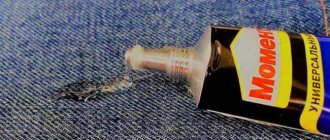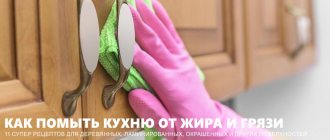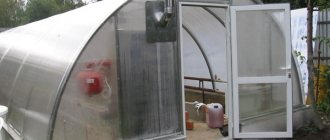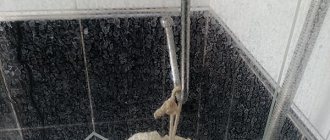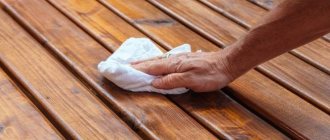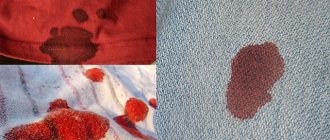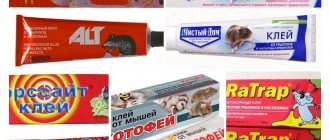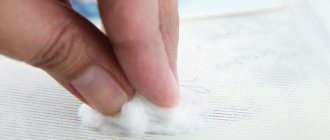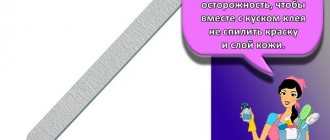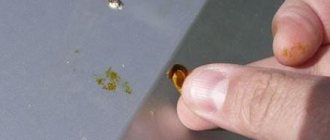When mice, rats and other rodents are noticed in the house, real chaos begins. It is customary to get rid of these little animals immediately, because the harm they cause is simply immeasurable: spoiled food supplies, chewed furniture, and even infections transmitted to people and their pets. Experts say that getting rid of rats and mice will take at least several days. One of the most effective tools for getting rid of rodents is mouse catching glue.
- Types of glue in mouse traps
- How to remove mouse catching glue from flooring?
- How to clean glue from linoleum
- Removing glue from the surface of furniture
- How to clean mouse catching glue from clothes and fabrics?
- Using household chemicals
- Using fat
- How to wash mouse glue off your hands?
- How to remove mouse glue from cat fur?
- Let's sum it up
A glue trap for mice allows you to quickly solve the problem with the appearance of these animals. In addition, it is often used to catch rats, which makes this tool truly universal. It is characterized by ease of use, but at the same time has specific rules of application. The point is that you need to be extremely careful, because the substance itself is extremely sticky.
If you use baits of this type carelessly, the adhesive composition will set almost instantly. You can only wipe it off experimentally, having tried several methods. Which ones? In this article we will tell you how to remove mouse glue and discuss the best methods that will help solve this issue.
Types of glue in mouse traps
Mouse glue comes in several varieties.
- Mousetraps or rat traps in the form of special bait houses on which glue is carefully distributed. Naturally, such rodent traps are more convenient indoors than other means. They are installed on surfaces favored by pests and do not require additional maintenance. Therefore, it is better to place them pointwise, in those places where mice have already been noticed. The use of such a rodent control product requires safe handling, as its improper use can lead to injury.
- Glue in a tube or jar for rat control. This is the more common form, but its main disadvantage is the difficulty in applying it evenly. However, such a product will not dry out even under conditions of high or, conversely, low room temperature. This glue should be applied to simple cardboard, which is for one-time use only. This means that as soon as the first mouse comes across it, the cardboard needs to be thrown away. Otherwise, natural decomposition of the animal will occur. In order for the trap to be more effective, pieces of bait must be placed on it. You can add millet and other cereals.
Naturally, both products have approximately the same composition. Therefore, regardless of the form in which the traps are presented, you can wipe off mouse glue using the same methods.
It is important to note that in rooms infested with rodents, a lot of glue-based baits will be needed. Therefore, it would be more expedient and much more humane to use an ultrasonic rat repeller. The fact is that animals are very susceptible to ultrasonic influence, and this method of repelling is guaranteed to save you from problems.
When deciding how to clean glue for mice and rats, you need to focus on the features of a particular product. Often, detailed recommendations for use are written on the labels of such products.
If a similar situation happens to you, we are in a hurry to help you figure out how to solve it correctly.
Why do mice appear in the house?
Mice poison the lives of the inhabitants of the house. When gray thieves first appear, it is necessary to take urgent measures to remove mice from the house before the number in the room increases. Long-tailed pests appear both in private homes and in multi-storey buildings.
The following factors increase the likelihood of a rodent infestation:
- Cluttered basements and old collapsed outbuildings are places where mice accumulate. The animals establish uninhabited territories and live there in large families.
- Rubbish heaps and uncollected landfills provide feeding grounds for rats and mice. When piles of garbage rise near residential buildings, rodents run to the warm, cozy walls of a residential building.
- Grocery stores are a tempting bait for gray animals. Cheeses, sausages and cereals attract mice to settle in secluded corners of retail premises. Rodents get into residential apartments if the premises are located on top or to the side of a shopping center.
- Pests can enter your home through transportation. For example, when receiving a set of new furniture. Mice hide in cardboard packaging and crawl out when assembling parts.
- Violation of sanitary standards leads to the appearance of mice. Scraps left on the table or garbage not taken out emit an odor that attracts rodents.
How to remove mouse catching glue from flooring?
Practice shows that the use of mouse traps most often stains the floor covering. This happens for several reasons: due to carelessness, the bait can simply turn over, you can accidentally apply too thick a layer of the substance, or simply inadvertently drip onto the floor.
The main advantage of this adhesive composition is that, thanks to a specially developed formula, it remains in a liquid state for a long time. It turns out that you will clearly find the stain itself in liquid form.
It is important to note that the most problems arise when the adhesive mixture gets on the carpet. In such situations, instead of worrying about how to remove mouse glue from your carpet, it is better to look for ways to disguise the stain.
There are two most common ways to clean mouse glue from the floor:
- Water with lemon juice. In one liter of heated water, dilute the juice of at least two large lemons and add a little ethyl alcohol. Wet a rag with the resulting solution and vigorously wipe the area with the spilled adhesive.
- Soapy liquid. Water with laundry soap diluted in it has approximately the same effect. This method will help you deal with stains of any complexity. We grate a whole bar of laundry soap. The resulting shavings are completely dissolved in hot water. We wait for the liquid to cool down. Using a soft sponge, wipe the stain until it disappears completely.
The main advantage of these methods is their safety. They can be used to clean painted carpet without disturbing the paint layer.
There are other products and methods for removing rodent adhesive that can be used exclusively for cleaning durable and inexpensive floor coverings. In particular, they are suitable for cleaning linoleum.
How to clean glue from linoleum
The use of sticky rodent repellent can lead to contamination of surfaces. You can remove glue from linoleum much easier and faster than from parquet or carpet. The main advantage of this flooring is its softness. However, it is also considered the main drawback - after all, the adhesive solution sets much faster with a soft coating. Therefore, you will have only a few minutes to decide how to clean the bait traces.
It is permissible to use aggressive chemicals, which, at the same time, should not have any properties that could affect the color of the coating. For this reason, you may well use an alcohol-based method for cleaning.
- We take pharmaceutical alcohol of high concentration. A higher degree will bring a more noticeable effect.
- We dip a rag in it and vigorously rub the area where the stain was placed.
- If the stain is too large and too much adhesive has been spilled, it is recommended to remove excess adhesive with a hard object or an ordinary construction spatula. If this is not done, there is a possibility of simply spreading the stain over an even larger area.
How to remove glue - methods
Theoretically, mouse glue can end up on any surface. Pets often step into it - cats, dogs, hamsters, which stain the fur. It happens that children get into the trap and then touch furniture and other things. Glue stains can end up on your hands and clothes if you are not careful during application. Even a gadget can be damaged, fortunately, its surface has a protective oleophobic coating that repels fat and any dirt.
How to remove glue from your hands
Your hands often get dirty with the substance, but you can’t just wash it off with water or soap. An adult without allergies or skin hypersensitivity can use aggressive solvents - acetone, kerosene. You need to soak a cotton pad or a piece of cloth in the solution, apply it to the stain, then wipe it off with active movements. Afterwards wash your hands with soap. You may need to repeat the procedure 2-3 times.
It is important not to keep the cloth on the skin for long, otherwise you may get burned. If redness or irritation appears, you must immediately stop the session, wash and dry your hands well. Such methods cannot be used for children's hands! For kids, you can remove the glue mark from the skin like this:
- soak a cotton pad in any vegetable oil;
- apply to skin for 10 minutes;
- Carefully wipe off the softened glue and wash your hands.
This method is harmless, gentle, and can be repeated as many times as necessary until your hands are completely clean.
How to clean the floor
Careless handling of glue leads to its appearance on the floor. When the adhesive has hardened, the floor can be carefully cleaned with a plastic scraper or spatula. If the glue is still soft, alcohol will remove it. You need to apply a cloth moistened with alcohol to the surface and wipe off the stain after 10 minutes. This way you get rid of the glue on the linoleum.
It is better to try to wash off the glue from laminate flooring with laundry soap. The wetted floor is washed with a thick soap solution using a hard sponge, then the residue is removed with water. The method of removing adhesive with lemon juice or citric acid solution is also popular among people, but they also need to be given time to act. There are also options to carefully clean the glue with sandpaper, wipe with acetone or vegetable oil. We must remember that these measures can spoil the surface and cause unsightly stains to appear on it.
Cleaning glue from furniture
A stain on a sofa or armchair is a real problem, because it is difficult to wash the product. But it is still possible to remove the glue using carpet cleaner, washing powder, or laundry soap. Do not rub the coating too hard - white spots may appear on it due to damage to the fabric fibers. You can try to wash the glue off leather furniture with soap or wipe it off with vodka.
Alcohol is not a damaging agent for wooden surfaces; it can be used more safely. Plastic and glass furniture cannot be damaged by alcohol, as well as chipboard and fiberboard. It is undesirable to use only hard brushes, which can leave scratches. Painted and varnished elements will have to be washed with powder, soap, thorough rinsing with water and quick drying with cold air.
How to remove glue from clothes, fabric, carpets
If you use organic solvents on textiles, there is a risk of severe damage to the product. You won't be able to remove glue from clothes with oil either: it will leave a greasy stain. You can try washing it by hand several times so as not to damage the washing machine with glue. Some people use aggressive toilet cleaners and grease solvents on household items. It is better to dry clean high-quality, expensive items.
Carpets should also be taken to professionals or use special cleaning products such as “Vanish”. Unfortunately, when fibers are impregnated with glue, it is not always possible to completely remove it, especially on natural and long pile.
How to remove glue from animal fur
Pets and fur can get into the glue trap, and their feathers immediately get dirty. To remove glue from a cat, dog, or other animal, you will have to cut off a piece of hair. For this purpose, you need to invite an assistant who will hold the animal while shearing, otherwise there is a risk of injuring it. A full haircut should only be done in a pet salon.
When a cat's paws are dirty, trimming it won't help. You will have to scrub off the glue with oil, and then wash it off the fur with a special shampoo for animals. You can also use vodka or alcohol to remove glue. It is not recommended to use perfume or cologne to avoid allergies in your pet. Acetone should absolutely not be used!
When using mouse glue, you should take precautions. You need to wear gloves when setting the trap; for rats, you should very securely fasten the board to the floor. It is necessary to choose the place where rodents most often appear and immediately warn your family about the installation of a trap. It is advisable to protect the glue trap from children and pets by any convenient means.
Removing glue from the surface of furniture
A more difficult task is the question of how to remove mouse glue from furniture. If such a product stains upholstered furniture, it is most likely that it will simply be impossible to save it. The adhesive composition contains substances that cause serious harm to fabric coverings. But washing a certain part of a sofa or chair is an impossible task.
The only ways to save the product is to use special carpet cleaners, liquid laundry detergent and a stiff brush. However, such brushes should not be used on delicate fabrics, as they can cause irreversible damage. In such situations, the only way out is to reupholster the furniture.
Restoring a hard furniture surface is a completely doable task. Cleaning natural wood will be especially easy. For such products you can use alcohol solutions. They can also be used to clean glass and plastic.
If you have to clean furniture made from wood substitutes or products with a painted surface, it is better not to take risks and use White Spirit, a solution of lemon juice or laundry soap. Naturally, you will have to work much longer and harder, but the material itself will suffer much less.
How to clean the floor
In village houses today, the floor is covered with different materials - linoleum, laminate. Most often, the floor remains wooden in the old fashioned way, especially in modern wooden houses. Different products are used to clean floors with different finishes.
It is important to remove adhesive contamination, so home owners are looking for the most effective ways
Wood
Popular ways to clean wooden floors from traces of mouse glue:
- Water with citric acid. For 1 liter of warm water take 2 tablespoons of lemon. Using the resulting solution with a hard sponge, you can remove the dirt by vigorously rubbing the area where the glue gets in contact.
- Water with laundry soap. A method that removes even dried stains. Soap dissolves in hot water; use a hard sponge to rub the stain vigorously until it is completely removed.
These are gentle methods because the wooden floor is usually painted, and you need to preserve the staining.
Linoleum
The softness of linoleum requires more aggressive cleaning methods. Alcohol-containing substances are used here. They moisten the cloth with which you need to vigorously rub the stained area. Undoubtedly, before treating with alcohol, the adhesive substance must be collected with a hard board or construction spatula.
How to clean mouse catching glue from clothes and fabrics?
When working with mouse glue, you need to be extremely careful, because you can stain not only the floor or furniture, but also wardrobe items. If such a situation occurs, you will have to think about how to wash mouse glue from clothes.
According to reviews, different adhesive mixtures are better washed off with different special-purpose products. However, almost all articles advising on the best way to remove glue agree that the main success is a prompt response to what happened.
Therefore, the sooner you can start cleaning the stain, the greater the chances of removing its remnants without serious consequences. After all, otherwise it would be wiser to take the item to the dry cleaner than to try to remove the stain on your own.
Using household chemicals
If you still need adhesive-filled fabric or items, try removing mouse bait stains with a heavy-duty household chemical that is not designed for washing items. These products include those designed for cleaning bathrooms or kitchen surfaces, or for washing glass or furniture.
Moreover, toilet cleaners will be an effective cleaning principle. In this case, the chances of restoring the item are approximately 50/50.
If the task is completed successfully, you should not wear the salvaged item of clothing immediately after drying. After the treatment, it must be washed two or three times with washing powder and rinsed with a special rinse aid.
Using fat
Lists of tips on how to remove glue from mice constantly suggest this non-standard method. Fat, oddly enough, also helps to cope with a surface contaminated with glue.
To do this, you will need to lubricate the adhesive spot with sunflower oil. Moreover, it is permissible to completely immerse the damaged part of the fabric in oil. There it needs to be kept for about five or ten minutes, depending on the size of the stain. After this, using a hard, clean object, you will need to carefully scrape the softened composition from the fabric.
Naturally, after such cleaning you will have to get rid of the greasy stain, which is still much easier than dealing with the remnants of the adhesive mixture. In the end, there is always the opportunity to take the item to the dry cleaner, where professionals will deal with the stain.
Washing clothes, fabrics
31.08.2018
Conclusion
Following these simple rules will allow you to keep your home clean and save you from many problems with stain removal.
To decide how to wash glue from mice, you need to familiarize yourself with its composition indicated on the packaging, the manufacturer’s recommendations and the properties of the solvents available at hand.
It is fundamentally important to answer where the composition ended up - clothing, open areas of the body, hair, pet hair, furnishings. Certain types of strong solvents should not be used on humans or animals.
Description of the problem
The composition that traps small rodents is specially developed from viscous polymers that have a melting point below room temperature, so it does not harden or dry out like solutions.
In most cases, the base (up to 80%) is polybutylene with the addition of cycloisane and polyisobutylene.
The suspension can be applied to old cardboard
Polymers are not toxic, but do not interact well with weak solvents.
These glue traps are available in 2 types:
- ready-to-use traps in the form of a strip with an adhesive layer covered with a protective film for transportation;
- suspension in tubes (jar), which is applied independently to the selected base in accordance with the manufacturer’s recommendations.
Hard case
The performance characteristics of mouse glue are specifically designed to instantly adhere to organic surfaces.
For the skin of the hands, exposure to these liquids in small quantities is usually acceptable, but removing the sticky mass from hair, pet fur, or fabric upholstery in this way will be not only difficult, but also practically impossible.
Safe ways to remove sticky glue from hair are:
- A haircut. If only the ends of long hair (wool, lint) are dirty, then it is better to trim them carefully, since treatment with synthetic or organic liquids will cause more damage to the undamaged part. It is recommended to choose this method for pets as well, otherwise it will take a lot of patience for both the pet and the owner while washing off the glue.
- The use of natural solvents (sunflower oil) and/or household chemicals. This is a more labor-intensive process, since it is necessary not only to remove dirt, but also to remove oil and synthetic detergents that are absorbed into the skin and hair. Grease removers (for example, dishwashing liquid) are used from household chemicals.
Oil will remove glue residue well, but not always the first time
Oil not only dissolves polymers, but also activates the process of self-cleaning of living tissues (the work of the sebaceous glands) and then mechanical removal of the adhered mass occurs along this film, so it is not always possible to remove the stain the first time.
READ MORE: Linoleum for bathroom walls, tips for selection and installation
In such cases, use an oil compress - generously lubricate your hand and wrap it in a thick cloth for 15-20 minutes, then rinse it off with a degreaser.
Removing stains
Sometimes rodents caught in a trap turn it over
Careful adherence to the rules specified in the instructions does not always free you from deciding how to wash glue from mice from the floor or other hard objects.
A large animal, caught in a trap, can turn it over and drag through the bar with the sticky mass.
This option can be prevented by nailing the trap or securing it securely in a suitable way.
On store shelves you can find the following types of rodent traps:
- The finished board on which it is applied. This substance contains components that attract mice with their smell. The mousetrap board is very easy to install. After removing the protective film, it is placed on the surface in a suitable place.
- In cans and tubes. In this case, there is a problem of uniform distribution. But there are also advantages - the product does not dry out, despite a certain room temperature.
It should be noted that, applied to cardboard, it can only be used once. After a mouse gets into it, such a trap is thrown away to prevent the animal from starting to decompose.
In other cases, millet and sometimes other grains are scattered on top of the cardboard. These traps are placed where mice appear most often.
These rodent mouse traps are also available to inquisitive pets. For this reason, the glue remaining on the paws and fur ends up spreading throughout the apartment. The usual way to wash a cat off the mouse sticky substance will not work. For this purpose, use vegetable oil, applying it to the fur of a dog or cat. Then, you should wash the animal with either laundry soap or dishwashing detergent.
The same procedure is carried out in veterinary salons or clinics. In a short time, employees of such organizations remove it without harm to the health of the animal.
Attempts to wash such a mixture if it gets on furniture or fabric are very difficult in practice. For this purpose, dishwashing liquid and oil are used. Although this method does not work 100%, since there is a risk of damage to the material. To remove mouse glue stains from the carpet, wash them with kerosene, after doing a test on an inconspicuous area.
Since the risk of spoiling the item is increased, it is best to seek help from a dry cleaner. Its employees have all the tools and skills needed to professionally remove glue from furniture and clothing.
It is easier to wash the glue off the floor:
- Moisten a clean rag with alcohol and gently wipe off the substance.
- Treat the contaminated area with a solution of lemon juice and water.
- Dilute laundry soap in 1 liter of water.
- If all efforts are unsuccessful, then you can use a spatula. Excess adhesive is removed with a hard sponge soaked in alcohol.
Wooden floors can be cleaned with solvent. But if there is paint on it, then there is a risk of defects. Because of this, it is removed from painted surfaces (including plastic) using vegetable oil. The greasy film is washed off with gentle movements with a soap solution.
Since its composition, when handled with it, can get on your hands, housewives want to know how to safely remove it from the skin. Usually either cotton or linen fabric is used.
A solvent, kerosene or nail polish remover containing acetone is applied to the material. Due to the pungent odor and bad effect on the epidermis of the hands, this method is considered not very popular.
Therefore, you can resort to using vegetable oil, for example, sunflower. This product dissolves glue without harming the skin. To do this, cover the area generously with oil, wrap it in cloth and leave it alone for 30 minutes. Then, using laundry soap or dishwashing liquid, rinse everything thoroughly with warm water.
The advantage of this method is that there is no negative effect on the skin, and mouse glue is removed 100%. If necessary, the procedure can be repeated.
About the author
All information on the site was created specifically to keep you up to date with the latest news. And also to make it easier for you to engage in individual construction or simple renovation of your apartment.
It is easier to wash off the substance from furniture that has a hard surface. Natural wood is cleaned with alcohol-containing products. Plastic, glass and painted surfaces are wiped with lemon juice or laundry soap.
We suggest you read: How to get rid of mice in a private house, how to deal with mice in a private house: a remedy for mice in the house, what are mice afraid of in the house, folk remedies
Contaminants can be easily washed off with the solvents specified on the manufacturer's packaging. You may have an analogue at hand, on which GOST or just the brand is indicated.
Household chemicals
Soiled items can be wiped off with household chemicals, which are intended for breaking down grease on kitchen stoves, cleaning the bathroom, and for washing glass and furniture. It is more effective to use toilet cleaners.
After cleaning, clothing should not be worn immediately. It must first be washed 2-3 times with powder and rinse aid.
You can clean the glue with sunflower oil. You need to rub the stain or dip the completely contaminated area into it. When soaking the fabric, it should be kept in oil for 5-10 minutes. When the adhesive has softened, it is scraped off the clothing.
Afterwards, you need to clean the clothes from oil stains yourself or take them to the dry cleaner.
How to wash mouse glue off your hands?
After catching a rodent, there is almost a 100% chance of getting dirty with such glue. And as soon as such an incident occurs, the question immediately arises of how to wash mouse glue off your hands.
Human skin is not as susceptible to the effects of an adhesive solution as, for example, fabric. However, when a certain amount of mouse glue gets on your fingers, it feels about the same as if they were glued together with superglue. It is quite possible to correct the situation with ordinary sunflower oil. It does not have a strong odor, which makes it safe even for children. So, it is completely harmless to the skin and can quickly dissolve the sticky layer of glue. At the same time, you can not be afraid to scrape off its remains. Indeed, it is likely that some dead skin will be removed along with the glue, but no pain or discomfort should arise from this.
Another good remedy that will allow you to quickly wipe off the adhesive mixture from the epidermis is acetone. A bottle of such liquid is undoubtedly in every woman’s cosmetic bag. This product is very safe for the skin, and its only drawback is the rather strong smell. It is important that allergy sufferers should absolutely not wash mouse adhesive with this substance. Those who are allergic to acetone should use the first method.
How to clean glue using different means
Sticky traps are most often placed on the floor in areas where rodents have been observed. It is clear that glue stains may end up on the floor - cunning animals overturn traps, causing the non-drying substance to be smeared onto adjacent pieces of furniture. When cleaning, it gets on clothes, and the ubiquitous cats can get dirty in the adhesive composition, because it remains liquid for a long time.
Important! Adhesive compositions do not contain toxic substances hazardous to humans and pets.
Vegetable oil
Clothes are cleaned of glue using improvised means. One of them is regular vegetable oil. They need to generously lubricate the area of contamination or completely immerse a section of fabric in oil poured into a bowl for 5-10 minutes. After this, carefully scrape off the sticky substance. At the same time, do not forget to protect your hands with gloves.
The fat base dissolves the adhesive substance, and the clothes are well cleaned. If necessary, oil treatment is repeated. After this, all that remains is to remove oil stains from the fabric. They are removed with warm water and laundry soap.
There is no negative effect on the skin and the removal of adhesive contamination is 100% guaranteed. By smearing oil on the fur of a cat, you can clean it of glue, and then rinse it off completely while bathing with soapy solutions.
Dish detergent
You can remove adhesive stains with dish soap. It is suitable for secondary processing, when the glue has already been removed from the surface of clothing or from the fur of a pet. After this, the animal can be bathed with dishwashing detergent. It is also good for washing off grease stains from clothes and for washing hands.
Kerosene
Kerosene shows high efficiency in removing adhesive contamination. But its use has an adverse effect on the skin of the hands and dries it out greatly. After cleaning the stains with kerosene, it is recommended to smear your hands with a rich cream with a nourishing effect on the skin and nails. It is best to work with kerosene with gloves, in the air, so as not to be poisoned by its vapors.
We must remember that kerosene has a pungent odor and has a detrimental effect on the epidermis. The smell of kerosene can be removed from clothes only by washing it several times.
Lemon juice
Lemon juice helps remove residual substances and greasy stains. Add 2-3 tablespoons of freshly squeezed lemon juice to a faceted glass of warm water. The solution is used to remove stains from clothes and hands. The fabric is soaked in the solution for 5-6 minutes, then the clothes are washed in the usual way.
See also
Rules for caring for suspended ceilings and the best cleaning products
Laundry soap
The adhesive composition is washed off the floor with laundry soap dissolved in water. A soap solution removes dirt from laminate and linoleum, if the stains are wiped well with a soapy sponge. The glue is first removed from the skin with sunflower oil, then treated with a solution of laundry soap. This method is also suitable for washing children, from whose skin mouse glue should be quickly removed.
How to remove mouse glue from cat fur?
Happy owners of pets have the hardest time dealing with mouse infestations. The cat family, due to its natural curiosity, is often interested in the contents of the mousetrap and gets dirty in glue. Let's talk about how to remove mouse glue from your pet's fur.
Before you wash the mouse glue off your cat, you will need to catch it. Cats are often afraid of getting into a sticky substance, so they try to run away and hide in a place that they think is calmer.
Assess the situation: how dirty is your animal? If the trap is firmly stuck to the pet, you will need to cut the trap itself with scissors. In this case, you need to try to cut the cover as high as possible. Pulling off hairs is strictly prohibited, as this can injure the animal.
If you are not sure that you will be able to unhook the trap yourself, or if it is attached too close to the skin, it is better to immediately take the cat to the veterinarian. It is prohibited to wet the animal's cover in order to remove the softened glue. There is simply no way to wash mice glue off a cat with water or other liquids. The damaged area will simply have to be carefully cut off. In this case, any water treatments will only bring additional stress to the cat.
If the cat has entered the glue directly with its paw, you can deal with the problem using a principle equivalent to removing mouse glue from human skin. Just soak the cat's paw in sunflower oil at room temperature. Once the glue has softened, gently scrape off the layer with a soft sponge or cloth. It is not recommended to use hard objects to avoid injuring your pet. After the stain is removed, it is recommended to wash the foot with soap or dishwashing detergent.
Let's sum it up
Rodents reproduce extremely quickly, so when they are detected, measures should be taken to eliminate them as quickly as possible. Some types of mouse trapping glue must be used with extreme caution, especially if there are children in the house. Read the instructions carefully before use.
To avoid having to deal with glue stains on different surfaces or on the fur of your beloved cat, you need to adhere to several important rules for using glue traps for rodents:
- Install them in places inaccessible to children or animals.
- Tell everyone in your household exactly where you set the traps.
- Do not place tubes of product close to upholstered furniture or clothing.
- Treat these substances like superglue. Take all appropriate precautions to prevent the negative effects of rat glue on various surfaces.
If you have any questions about how to properly apply mouse glue, we recommend watching the video:
How to wash animal hair
If a pet climbs onto the plate, carefully free it from the adhesive base. The best way to cut off a matted area of fur is to cut it off. Of course, if it is a very large area of fur, then one haircut will not do. Again resort to using sunflower fat. Soak a soft cloth well in the oil and wipe off the mouse glue. Then, bathe your curious pet in soapy, warm water. Dry the animal's fur with a towel. You can also turn to alcohol-containing solutions: 70% alcohol, cologne, alcohol tinctures. Voila, your miracle is saved, and don’t be upset that you spent a lot of time and effort on it. Next time, place the sticky trap out of reach of pets.
